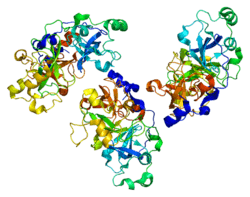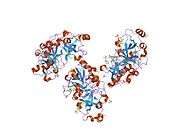L3MBTL
| View/Edit Human | View/Edit Mouse |
Lethal(3)malignant brain tumor-like protein is a protein that in humans is encoded by the L3MBTL gene.[3][4][5]
This gene encodes the homolog of a protein identified in Drosophila as a suppressor of malignant transformation of neuroblasts and ganglion mother cells in the optic centers of the brain. This gene product is localized to condensed chromosomes in mitotic cells. Overexpression of this gene in a glioma cell line results in improper nuclear segregation and cytokinesis producing multinucleated cells. Alternatively spliced transcript variants encoding different isoforms have been identified.[5]
References
- ↑ "Human PubMed Reference:".
- ↑ "Mouse PubMed Reference:".
- ↑ Koga H, Matsui S, Hirota T, Takebayashi S, Okumura K, Saya H (Sep 1999). "A human homolog of Drosophila lethal(3)malignant brain tumor (l(3)mbt) protein associates with condensed mitotic chromosomes". Oncogene. 18 (26): 3799–809. doi:10.1038/sj.onc.1202732. PMID 10445843.
- ↑ Trojer P, Li G, Sims RJ III, Vaquero A, Kalakonda N, Boccuni P, Lee D, Erdjument-Bromage H, Tempst P, Nimer SD, Wang YH, Reinberg D (Jun 2007). "L3MBTL1, a histone-methylation-dependent chromatin lock". Cell. 129 (5): 915–28. doi:10.1016/j.cell.2007.03.048. PMID 17540172.
- 1 2 "Entrez Gene: L3MBTL l(3)mbt-like (Drosophila)".
Further reading
- Gerhard DS, Wagner L, Feingold EA, et al. (2004). "The status, quality, and expansion of the NIH full-length cDNA project: the Mammalian Gene Collection (MGC)". Genome Res. 14 (10B): 2121–7. doi:10.1101/gr.2596504. PMC 528928
 . PMID 15489334.
. PMID 15489334. - MacGrogan D, Kalakonda N, Alvarez S, et al. (2004). "Structural integrity and expression of the L3MBTL gene in normal and malignant hematopoietic cells". Genes Chromosomes Cancer. 41 (3): 203–13. doi:10.1002/gcc.20087. PMID 15334543.
- Li J, Bench AJ, Vassiliou GS, et al. (2004). "Imprinting of the human L3MBTL gene, a polycomb family member located in a region of chromosome 20 deleted in human myeloid malignancies". Proc. Natl. Acad. Sci. U.S.A. 101 (19): 7341–6. doi:10.1073/pnas.0308195101. PMC 409920
 . PMID 15123827.
. PMID 15123827. - Wang WK, Tereshko V, Boccuni P, et al. (2004). "Malignant brain tumor repeats: a three-leaved propeller architecture with ligand/peptide binding pockets". Structure. 11 (7): 775–89. doi:10.1016/S0969-2126(03)00127-8. PMID 12842041.
- Boccuni P, MacGrogan D, Scandura JM, Nimer SD (2003). "The human L(3)MBT polycomb group protein is a transcriptional repressor and interacts physically and functionally with TEL (ETV6)". J. Biol. Chem. 278 (17): 15412–20. doi:10.1074/jbc.M300592200. PMID 12588862.
- Strausberg RL, Feingold EA, Grouse LH, et al. (2003). "Generation and initial analysis of more than 15,000 full-length human and mouse cDNA sequences". Proc. Natl. Acad. Sci. U.S.A. 99 (26): 16899–903. doi:10.1073/pnas.242603899. PMC 139241
 . PMID 12477932.
. PMID 12477932. - Deloukas P, Matthews LH, Ashurst J, et al. (2002). "The DNA sequence and comparative analysis of human chromosome 20". Nature. 414 (6866): 865–71. doi:10.1038/414865a. PMID 11780052.
- Fossey SC, Mychaleckyj JC, Pendleton JK, et al. (2001). "A high-resolution 6.0-megabase transcript map of the type 2 diabetes susceptibility region on human chromosome 20". Genomics. 76 (1–3): 45–57. doi:10.1006/geno.2001.6584. PMID 11549316.
- Dias Neto E, Correa RG, Verjovski-Almeida S, et al. (2000). "Shotgun sequencing of the human transcriptome with ORF expressed sequence tags". Proc. Natl. Acad. Sci. U.S.A. 97 (7): 3491–6. doi:10.1073/pnas.97.7.3491. PMC 16267
 . PMID 10737800.
. PMID 10737800. - Ishikawa K, Nagase T, Suyama M, et al. (1998). "Prediction of the coding sequences of unidentified human genes. X. The complete sequences of 100 new cDNA clones from brain which can code for large proteins in vitro". DNA Res. 5 (3): 169–76. doi:10.1093/dnares/5.3.169. PMID 9734811.
This article is issued from Wikipedia - version of the 6/6/2016. The text is available under the Creative Commons Attribution/Share Alike but additional terms may apply for the media files.






